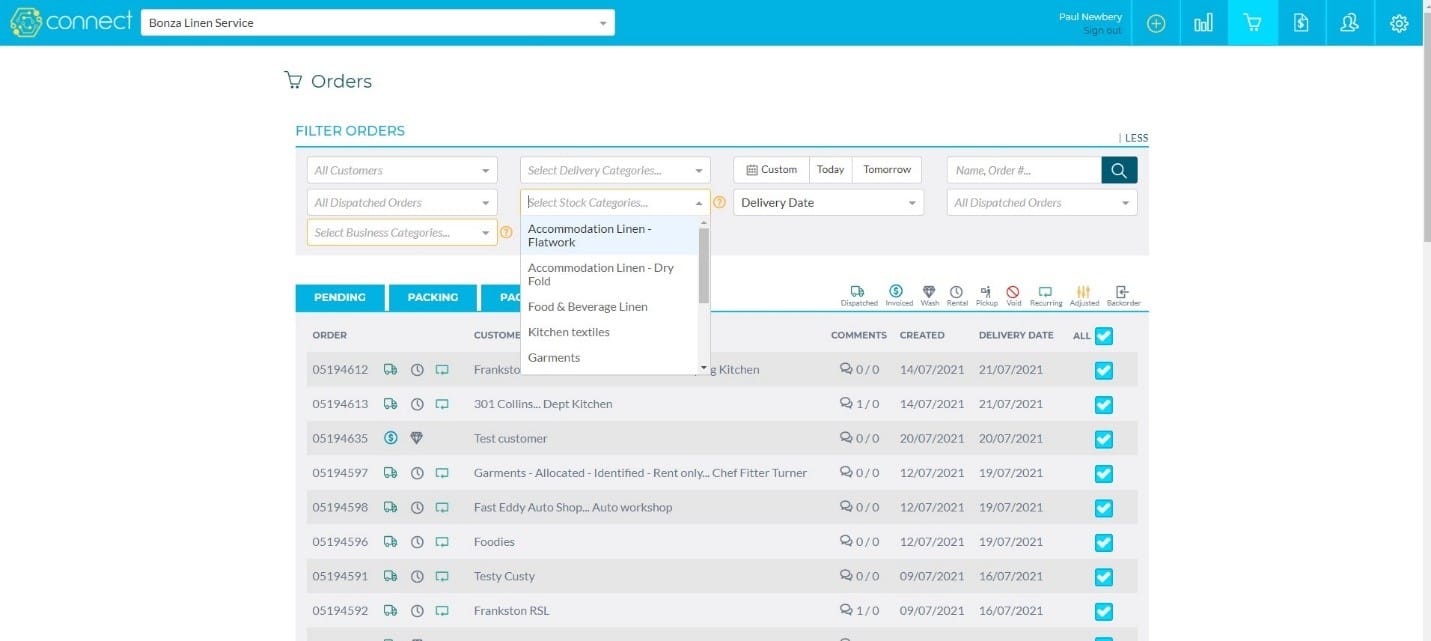Should you invest in a linen inventory management system?
Discover 4 crucial signs that your business needs a linen inventory management system to boost your linen operations.
Should you invest in a linen inventory management system?
Discover 4 crucial signs that your business needs a linen inventory management system to boost your linen operations.
Have you recently noticed some cracks in your linen operations affecting your business’s profitability and lowering your employees’ productivity? From linen losses to extended periods spent manually sorting and tracking linen items, linen operations can be fraught with challenges.
So what are the crucial signs that indicate that your linen operations aren’t going as smoothly as they should? Frequent issues in linen operations will typically exhibit the following signs:
- Stock shortages
Frequent stock shortages of linen can have a negative impact on day-to-day operations and customer satisfaction. If the inventory is not enough, you may not have enough linen to cover your clients’ requests, and this leads to the delay of business, inconveniencing customers and perhaps even losing profit. Stock shortages can be due to not having clear visibility into your linen inventory, inaccurate forecasting, or poor replenishment processes. - Inconsistent quality of linens
Maintaining consistent quality of linens is essential for upholding your brand’s reputation and meeting customer expectations. However, linen operations can sometimes struggle with inconsistencies, such as some items being stained, worn, or damaged while others are in pristine condition. This can be the result of improper sorting, tracking, and management of your linen inventory, leading to the use of subpar items and dissatisfied customers - Rising operational costs
Inefficient management of linen can cause a significant increase in your business’s running costs, which can negatively impact your costs. Frequent linen losses are caused by mismanagement or theft, poor utilisation of linens, and relying on manual tracking systems that always take time and lead to human-prone errors, contributing to a rise in operational costs. Without an efficient system, resource allocation may also be poorly managed. - Increased customer complaints
When linen operations are not running smoothly, they often manifest in the form of increased customer complaints. Clients may express dissatisfaction with the quality, availability, or timeliness of the linen you provide. These complaints can damage your reputation and jeopardise client relationships, ultimately impacting your bottom line, which may affect your ability to attract new clients in the future, due to your service ratings taking a hit.
If you find your business struggling with any of these 4 signs in your linen operations, perhaps it’s time to opt for a linen inventory management system, which is efficient in transforming your linen operations by reducing costs, improving efficiency, and enhancing customer service.
Have you recently noticed some cracks in your linen operations affecting your business’s profitability and lowering your employees’ productivity? From linen losses to extended periods spent manually sorting and tracking linen items, linen operations can be fraught with challenges.
So what are the crucial signs that indicate that your linen operations aren’t going as smoothly as they should? Frequent issues in linen operations will typically exhibit the following signs:
- Stock shortages
Frequent stock shortages of linen can have a negative impact on day-to-day operations and customer satisfaction. If the inventory is not enough, you may not have enough linen to cover your clients’ requests, and this leads to the delay of business, inconveniencing customers and perhaps even losing profit. Stock shortages can be due to not having clear visibility into your linen inventory, inaccurate forecasting, or poor replenishment processes. - Inconsistent quality of linens
Maintaining consistent quality of linens is essential for upholding your brand’s reputation and meeting customer expectations. However, linen operations can sometimes struggle with inconsistencies, such as some items being stained, worn, or damaged while others are in pristine condition. This can be the result of improper sorting, tracking, and management of your linen inventory, leading to the use of subpar items and dissatisfied customers - Rising operational costs
Inefficient management of linen can cause a significant increase in your business’s running costs, which can negatively impact your costs. Frequent linen losses are caused by mismanagement or theft, poor utilisation of linens, and relying on manual tracking systems that always take time and lead to human-prone errors, contributing to a rise in operational costs. Without an efficient system, resource allocation may also be poorly managed. - Increased customer complaints
When linen operations are not running smoothly, they often manifest in the form of increased customer complaints. Clients may express dissatisfaction with the quality, availability, or timeliness of the linen you provide. These complaints can damage your reputation and jeopardise client relationships, ultimately impacting your bottom line, which may affect your ability to attract new clients in the future, due to your service ratings taking a hit.
If you find your business struggling with any of these 4 signs in your linen operations, perhaps it’s time to opt for a linen inventory management system, which is efficient in transforming your linen operations by reducing costs, improving efficiency, and enhancing customer service.
The benefits of investing in a linen inventory management system
Efficient linen counting
Part of the linen counting procedure can be automated in order to improve accuracy, prevent mistakes, and simplify the procedure, which would eventually save time and resources.
Improved textile monitoring and utilisation:
Tracking linen orders across the whole of the hospital helps in enhancing care and linen utilisation, thereby ensuring sufficient linen at all times.
Expedited order process:
By developing a customer portal where clients can place their orders at their convenience, customer satisfaction will improve, hence communication with clients will be efficient.
Real-time inventory monitoring:
Real-time Inventory tracking can be used to determine where linen items have been misplaced or stolen, providing a conduit for tighter control of overall inventory.
Automated data analysis:
A linen management system having the ability to conduct data analysis can automatically assist you in identifying patterns and trends in linen usage and inventory levels.
Boost your linen operations with a linen inventory management system
Bundle Track is a revolutionary laundry asset management system that can help businesses improve their linen management pipeline by simplifying and streamlining processes.
With its cloud capabilities, it is able to read information transmitted from an RFID chip embedded in a linen cloth. Information can be relayed from the software about a linen item’s location in real time, decreasing incidents of lost items due to theft or misplacement.
This system can significantly reduce a business’s expenditure needed to replace lost items. Its user-friendly features make it easy for employees to monitor linen utilisation and track linen inventory statuses. With Bundle Track, businesses can maximise their cost-saving measures, boost workforce productivity, and improve overall ROI.
Bundle Track is a revolutionary laundry asset management system that can help businesses improve their linen management pipeline by simplifying and streamlining processes.
With its cloud capabilities, it is able to read information transmitted from an RFID chip embedded in a linen cloth. Information can be relayed from the software about a linen item’s location in real time, decreasing incidents of lost items due to theft or misplacement.
This system can significantly reduce a business’s expenditure needed to replace lost items. Its user-friendly features make it easy for employees to monitor linen utilisation and track linen inventory statuses. With Bundle Track, businesses can maximise their cost-saving measures, boost workforce productivity, and improve overall ROI.

Client success stories
"The transition to Bundle has been instrumental in Allied Laundry continuing to drive change and business improvement by providing real-time customer ordering information, streamlined ordering, and billing processes and have enabled a considerable reduction in staff time. The system has been a real success story for Allied Laundry."
Mark Mabbet
Allied Laundry Service
"No question is a stupid question in the eyes of the Bundle team. Their customer service, expertise and knowledge ensured a smooth transition for me when I purchased my business. The system is user friendly and easy to navigate, while syncing seamlessly with my accounts package."
Geraldine Minogue
Associated Laundry Services
Since the transition from a manual, paper-driven system to Bundle, the time spent managing orders through to invoicing has been reduced by some 75%. From an administrative perspective, it is far easier to track the progress of orders, respond to queries (and resupply dockets).
The management abilities for individual account needs with set days, recurring orders, fixing cut-off times, adding notes to orders and pick-ups means that all relevant persons have the same information.
Customer support is also given a high priority and queries and concerns are met promply and efficiently.
Cynthia Hertrick
Blueline Laundry
Book a demo
Streamlining your linen management process is now easier with our linen tracking technology.
Get in touch with us to book a demo.
FAQs
Soiled linens are collected, sorted, and sanitised in industrial washers. Fresh linen items are then folded and delivered upon request. Bundle Track offers a meticulous system to keep linen flowing. This cycle ensures a clean and well-stocked supply for every need, optimising linen management operations.
Radio-frequency identification (RFID) technology is a key feature of Bundle Track. RFID tags are embedded within linen items, functioning as unique identifiers that allow for real-time tracking via scanners. This data provides valuable insights into linen location (currently in use, laundering, storage), facilitating timely identification of damaged items and minimising loss.

